Technological development has become exponential, while entering a new era of globalization: the age of technology. In the area of interconnection and complexity, causing explosions that change the way the world economy works today.
Why is Europe lagging behind?
If we wanted to answer this question with a map, the best would be the one showing the distribution of the world's top one hundred startups.
The technology market map of December 2020
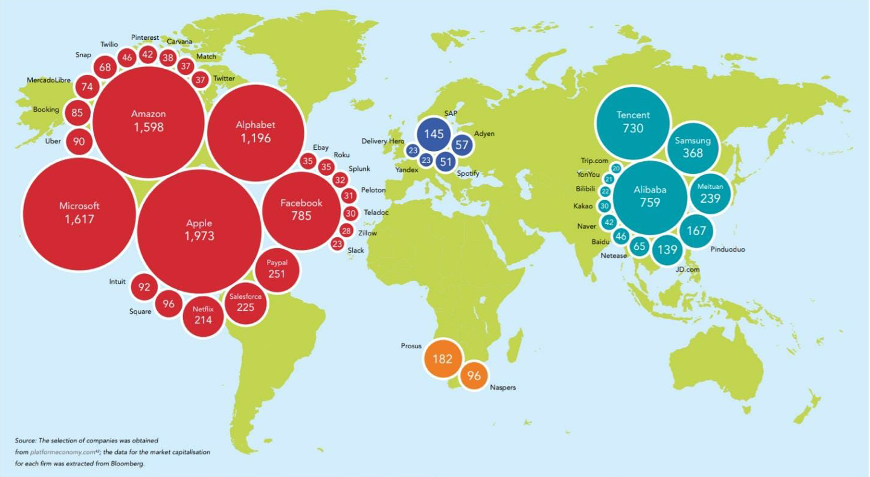
Forrás: platformecnomy.com
Europe has lagged behind the world economy because it has not been able to pick up speed and competition in terms of technology companies as well as technology factors. Moreover, if we add a Map of Unicorns, even India will overtake Europe in this race. In the first decade of the 2000’s, the world pulled away from Europe, both the United States and especially China, which has launched the largest and most global startups in the past decade.
From 2013, a new technological explosion started, where platforms, new technologies, new battlefields and new players have already emerged. Today, world leadership is also taking place on the technology front. In Europe, Scandinavia and the Baltic states stand out. Estonia has the third highest number of startups per capita in the world. In 2017, it generated more venture capital funding per capita than Germany, France and Spain.
The four driving forces of the 21st century are digitalization, automation, robotics, and artificial intelligence.
The trade war between the US and China is clearly about technological priority, and China seems to be taking the lead. China alone has more than a third of artificial intelligence servers. Only in 2018, a new start-up Unicorn was born every four days.
The world's 200+ Unicorn companies, on a huge map
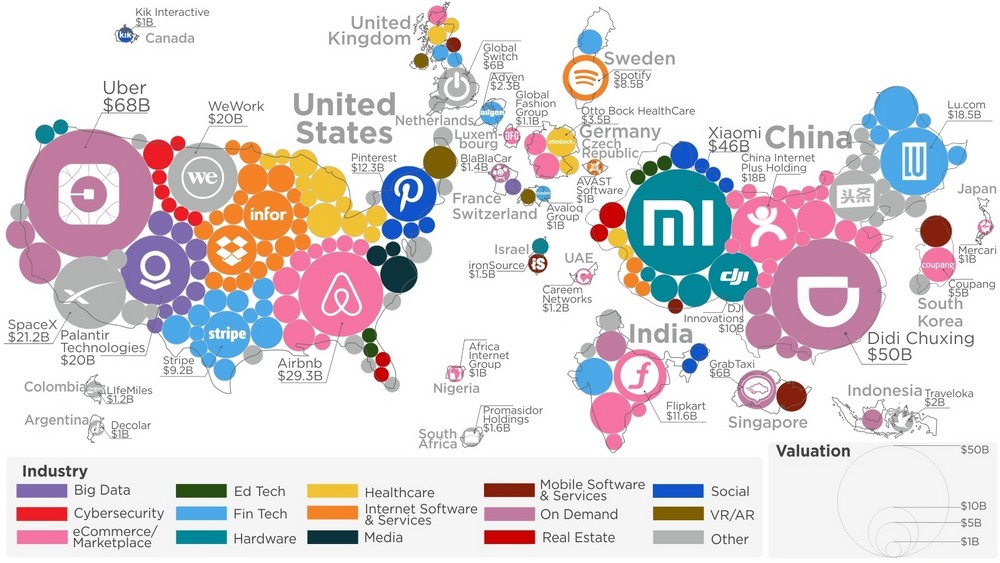
Forrás: Howmuch.net
This map presents the location of unicorns in the world, i.e., startups worth more than $ 1 billion by various sectors.
Today, there are 214 unicorn companies totaling $ 744 billion.
Exponential development
Exponential development is not evenly distributed and can only create abundance at the cost of sharp inequalities. The technological explosion can really be fully understood with the help of the Fourth Industrial Revolution. The Industrial Revolution fundamentally changed humanity's relationship with nature, the way it produced economically, and, as a result, how it dealt with everyday life.
The current fourth industrial revolution is characterized by a fusion of different technologies that blurs the line between the physical, digital and biological spheres, raising not only the transformation of different disciplines, economies and industries, but also the question of the role of mankind.
The new technological era is characterized by inventions and research directions such as artificial intelligence, robotics, the Internet of Things, self-driving cars, 3D printing, nanotechnology, biotechnology, materials science, energy storage research, or quantum computation and information. As a practical consequence of scientific and technological development, production is becoming more flexible. Joe Hellerstein, a professor of computer science at, the UC Berkeley said we are "living the industrial revolution in data" today.
Big data will be a new raw material for the economy: a new input that can be equivalent to capital and labor.
While the largest companies in the 1990s were oil companies, from 2013 onwards, globally, technology giants took the lead. In 2019, the role of technology companies will become increasingly important among the 100 largest companies in the world.
The fate of the largest American companies perfectly illustrates how the industrial revolutions reshaped the structure of the world economy and how we moved from the golden age of heavy industry after the reign of the oil industry to the era of communal spaces. In a century, big steel companies have been replaced by tech giants.
The Great Change of Era and the New Growth Paradigm
In his book titled "The Great Change of Era", Zoltán Cséfalvay writes about the change of technological era as follows:
Nowadays, we live in a series of very fast, almost untraceable, technological changes, regardless of how many industrial revolutions it has: new technologies, new economic organization principles, new consumption patterns, new employment models, new battlefields, new generations, new myths, new dynamics, and new ‘technological continents’ have emerged.
GAFA (Google, Amazon, Facebook and Apple), or now rather GAMA (Google, Amazon, Microsoft, Apple) are the platform-building NATU (Netflix, Uber, Alibaba, Airbnb) as well as the Chinese platform giants, which its mosaic letters draw the BATX (Baidu, Alibaba, Xiamoi, Tencent) technology continent.
"GAMA" is a breakthrough in the TOP 50 global brands in the world in 2020
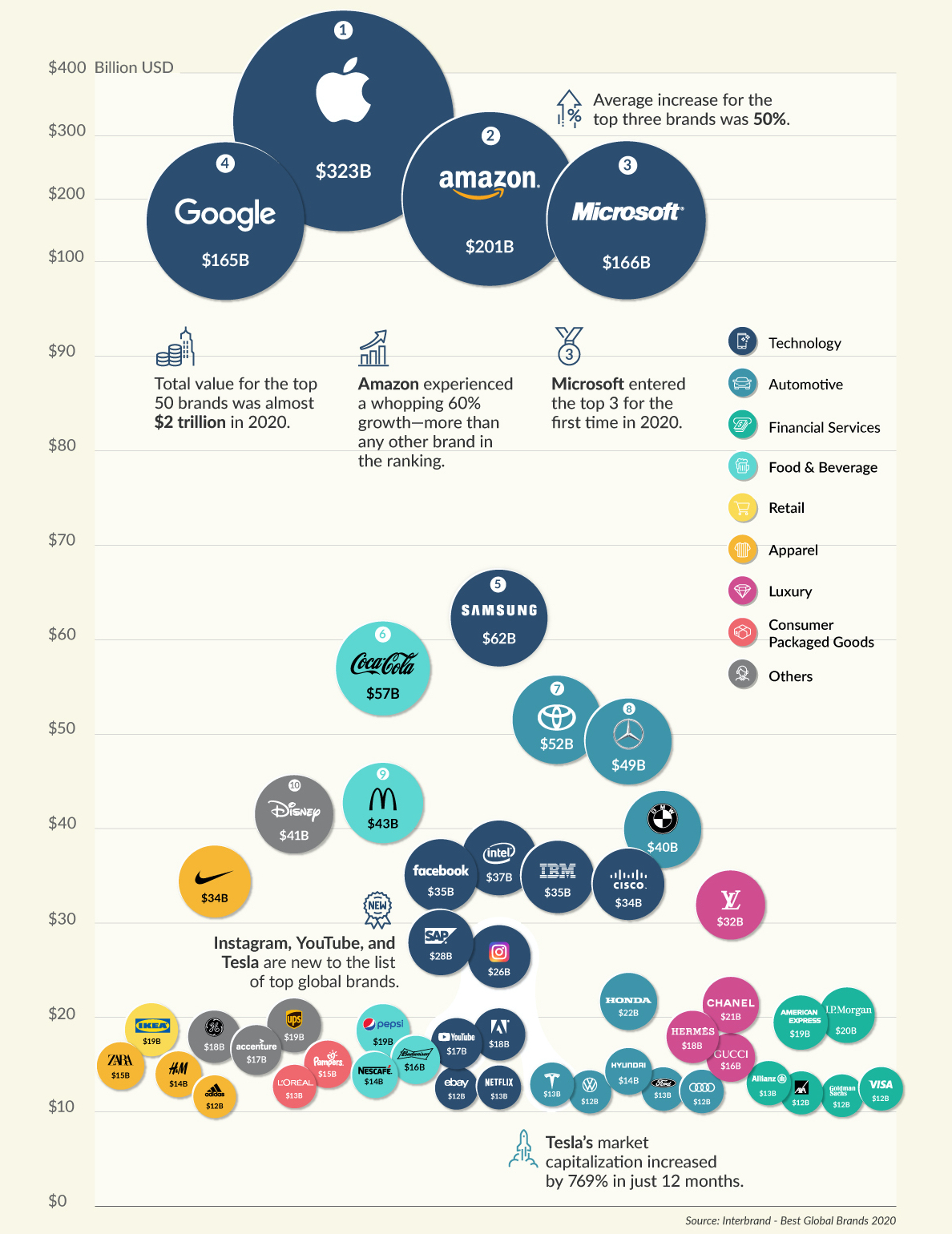 Forrás: visualcapitalist
Forrás: visualcapitalist
While the period up to the end of the 1980’s and 2000’s marked the era of globalization, in the 2010’s we entered a new era, the age of technology. The biggest innovation of globalization has been to build production and value creation networks that bring together many countries, many companies, and many sites using a system of global value chains. In contrast, in the age of technology, the focus of value creation within global value chains is gradually shifting towards digital technology and content, creating the opportunity to produce close to the consumer market, thus opening up the possibility of global value chains to smaller businesses..
The importance of digital platforms
As Zoltán Cséfalvay points out in his book, the emergence of digital platforms has triggered five radical changes: the use instead of ownership, purchasing of service instead of industrial products, increasing of market efficiency instead of the production of productivity, furthermore the focus on platforms instead of companies, and giving priority to self-employment instead of shared employment.
Digital platforms are transforming all services today, from the automotive industry through tourism to the service sector. An important change is that in the digital economy, we can now access a growing range of goods and services for free - just think of the background of Google, Gmail, or Viber. In 2020, as a result of the global spread of the coronavirus, platforms benefited from traditional business models. Between January and October 2020, the world’s top 100 platforms increased their total value by 40 percent to $ 12.6 billion.
The world's 100 largest technology platform companies in October 2020
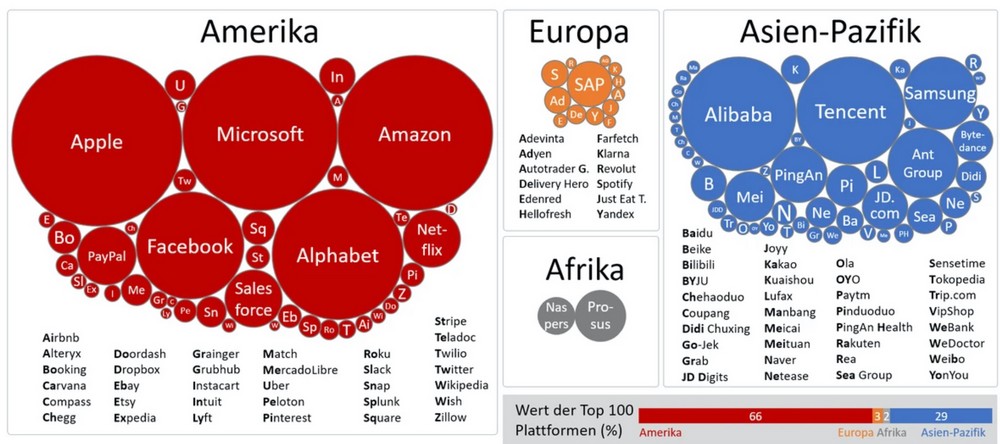
Forrás: Ecodynamics.io
Two-thirds of the value of global startups continues to come from the U.S., but the greatest dynamism is observed in Asia: 30 percent of the values and 45 percent of companies come from the region.
Meanwhile, a number of Asian platform companies are also represented in the underlying rankings, mainly from the B2B sector. In contrast, Europe's share has now fallen to 2.7 percent. While companies like Spotify, Adyen or Hellofresh have developed well, they can barely keep up with dynamism and the amount of investment in other parts of the world. As a result, the numbers of European companies in the top 100 have dropped to 12.
New Technology Continents: GAMA and BATX = GAMT
The biggest absolute growth this year was in Amazon (+ $ 604 billion), followed by Apple (+ $ 535 billion), Microsoft, Tencent and Alibaba. The relative growth list is The value of the world's 20 most valuable technology brands in 2020
The value of the world's 20 most valuable technology brands in 2020
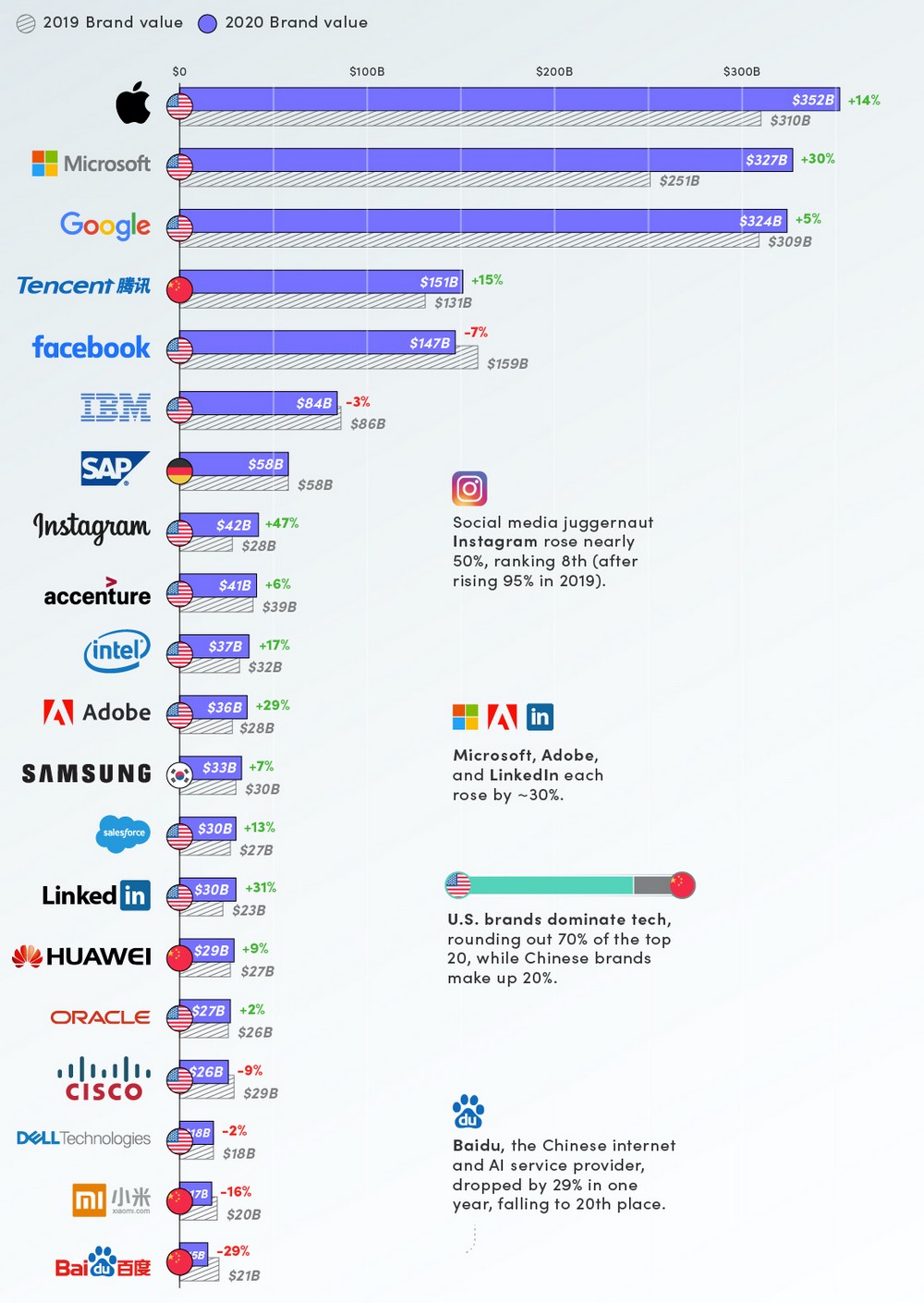
Forrás: Bloomberg
The Covid-19 epidemic is another powerful catalyst that further strengthens the power of Big Tech companies. Research on the business models of Alphabet (Google), Apple, Amazon, Facebook, Microsoft, Alibaba and Tencent shows how the 2008 financial crisis accelerated the market trend. Big Tech companies stand out compared to other sectors. Compared to S&P 500 companies, they have more financial assets at their disposal and follow a business model that relies more heavily on intangible assets such as patents.
The TOP 100 brands by economic sectors and the TOP 50 most visited websites before the pandemic
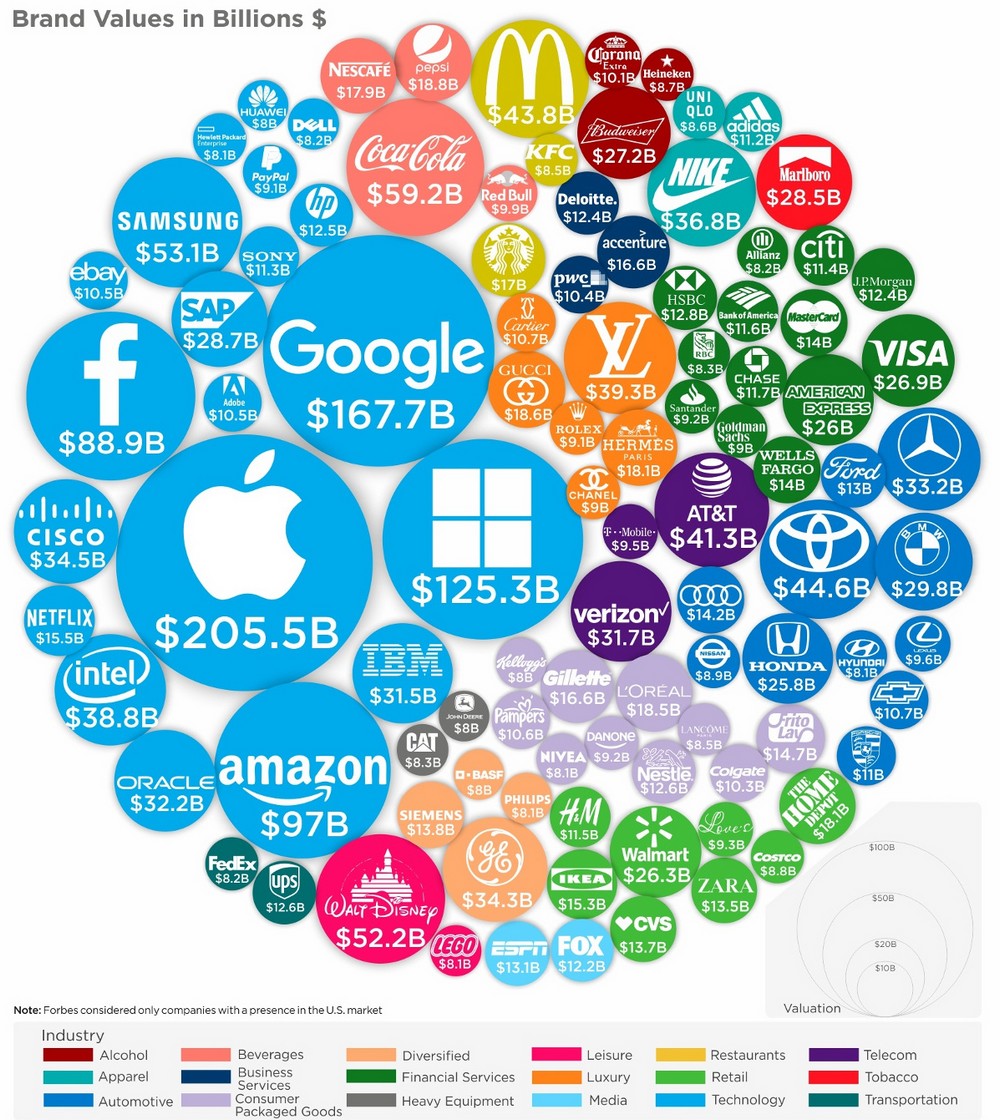
Forrás: Howmuch
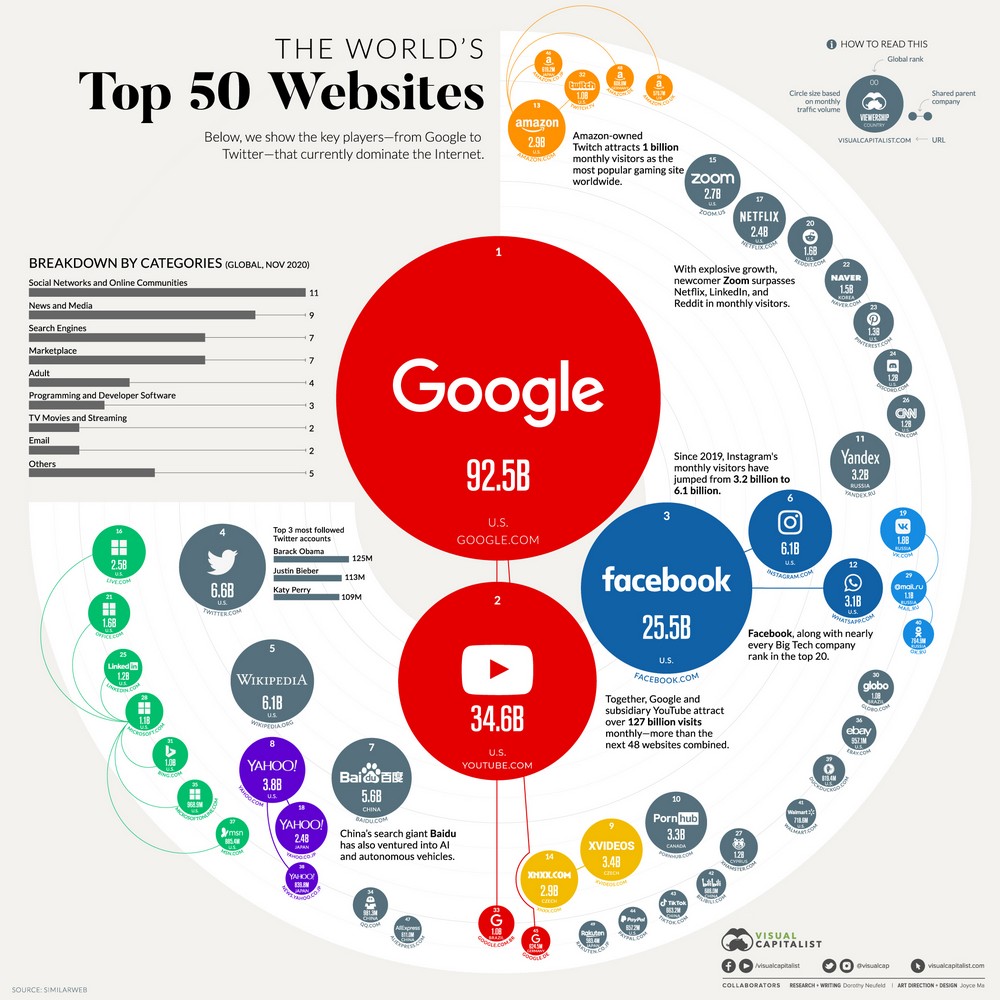
Forrás: Visualcapitalist
Which technology companies are the winners of the 2020 pandemic?
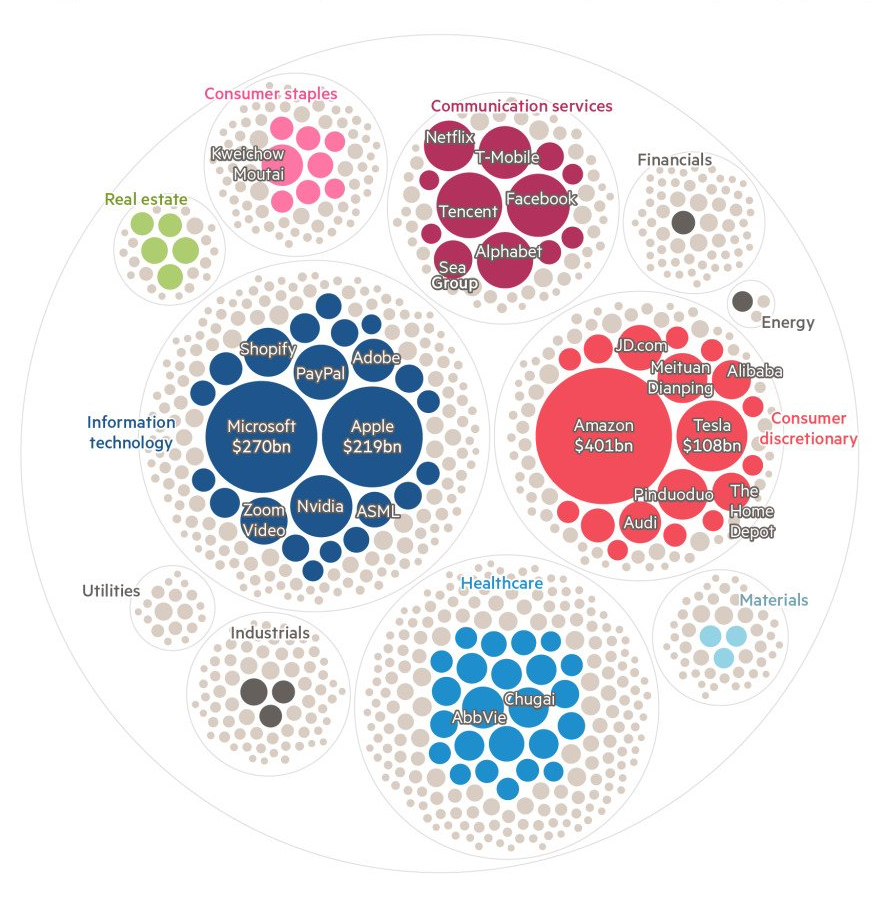
Forrás: Capital IQ
The fusion of innovation and geopolitics as the greatest challenge of our time
According to George Friedman, a Hungarian-born American geopolitical forecaster and head of Geopolitical Futures, innovation is one of the most important geopolitical miracles today, as for the first time, countries poor resources that invest in education and technology can compete with regions rich in resources.
According to Friedman, a distinction must be made between science, technology and innovation. Innovation is a simple answer to a vital need.
However, technology that uses innovative results from science has life cycles. It takes about 50 years for a new technology to reach its own maturity and then begin to decline. According to Friedman, we are currently living in an age of microchip technology that enables both the Internet and social media, which spread around the 1970’s and is now at its peak. It is expected to remain important in the future, but it will no longer be the most significant innovative area. Starting from the pattern of human history, we need to find something new that is currently invisible. According to George Friedman, this is in the fusion of the military and health industries.
The Silicon Valley 97 as a "high-tech oasis" of the world
The undisputed center of microchip technology is Silicon Valley, located in the southern state of San Francisco Bay, California, USA. Its center is between San Francisco and San Jose. The importance of Silicon Valley is given by the fact that it has been the site of high-tech developments such as integrated circuits, microprocessors, and personal computers, which have set the direction for the development of industry and everyday life for decades. In addition to a large number of highly qualified engineers, scientists and economists, the best universities (eg Stanford, Berkley, Caltech) are also located here.
Silicon Valley is home to world-renowned companies and technology centers
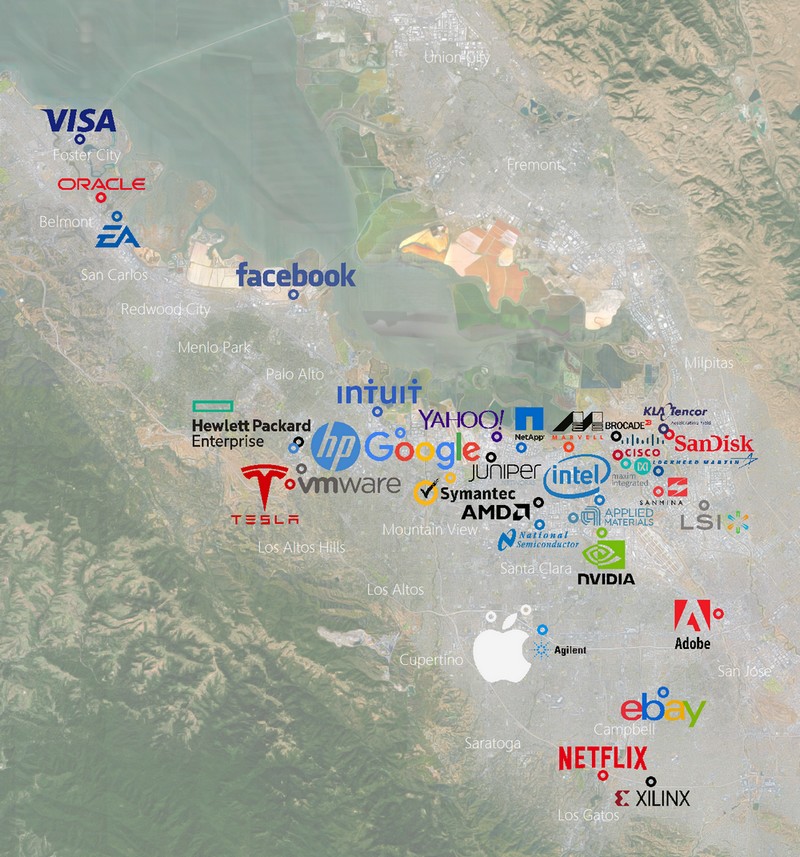
Forrás: Reddit
As a result of the success of Silicon Valley, the names "Silicon" for technology parks and centers have become popular around the world. These business networks and designers prefer to use the names "Silicon Valley, Oasis, Pool or Corridor.” Criteria for the creation of Silicon Valley-type technology zones are the extent to which they spend on research and development, the proportion of technology employees and technology firms, the area’s ability to raise venture capital, and the number of major higher education institutions in the zone.
Today there are of 97 Silicon Valley-type technology zones, created in the world under the name “Silicon.”
Silicon Valley type technology zones in the world in 2018
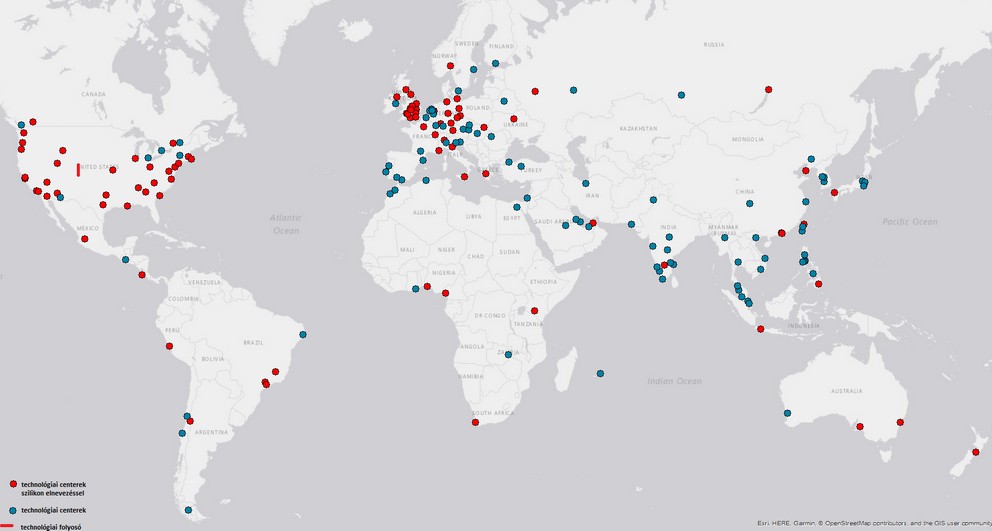
Legend: red - technology centers called silicon, blue - technology centers
Where are trends dictated?
The Startup Ecosystem Report of 2018 lists 8 key factors that are essential for becoming a startup city: these are the proper business start-up environment; adequate funding; adequate performance; entrepreneurial mindset; dictating a new trend; adequate support; application of talents and uniqueness. The world's 20 leading startup urban regions are Silicon Valley, Tel Aviv, Los Angeles, Seattle, New York City, Boston, London, Toronto, Vancouver, Chicago, Paris, Sydney, Sao Paulo, Moscow, Berlin, Waterloo ( Canada), Singapore, Melbourne, and Bangalore, Santiago.
The battlegrounds of global brand dominance: the most popular consumer brands by country
AThe world of commerce is dominated by a few big brands. In the fashion industry alone, 20 large companies control 97% of global retail profits. UK Business Financing was looking for the answer to which is currently the most popular consumer brand in the world in each country.
The most popular consumer brands by countries
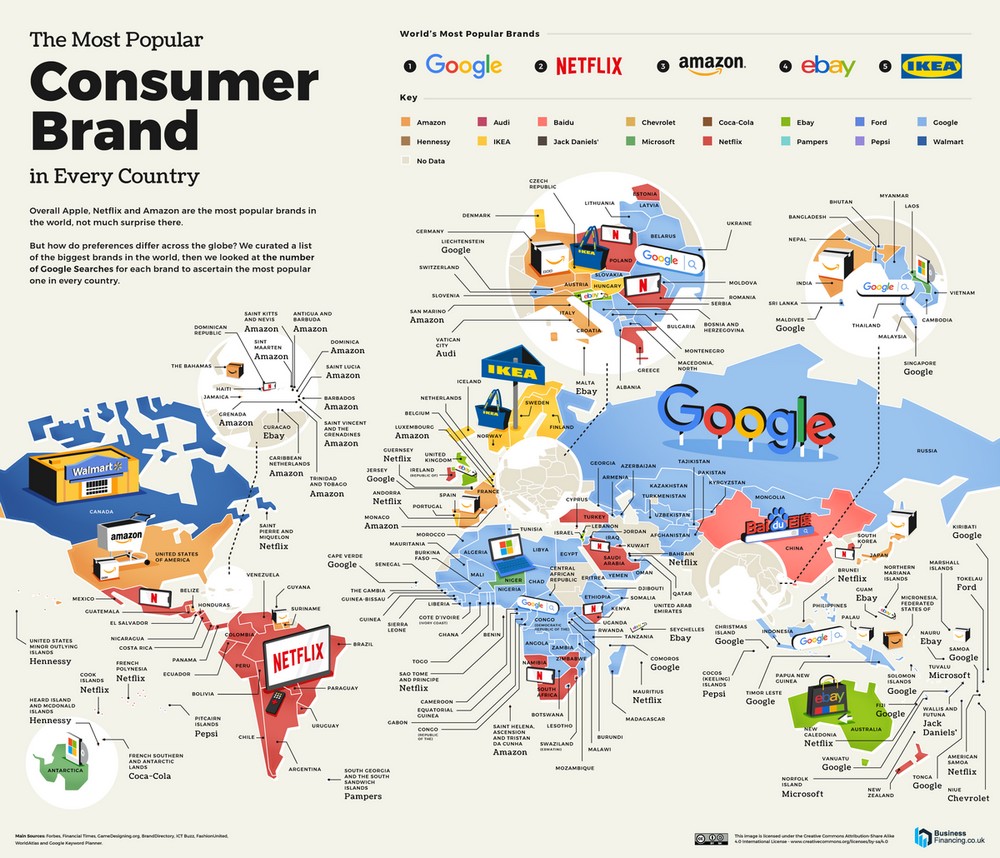
Forrás: businessfinancing
The world’s most popular consumer brands are overwhelmingly online companies. In fact, the top four brands are Google (100 countries), Netflix (45), Amazon (30) and eBay (11). Amazon’s success is all the more significant as it is present in only 18 countries, yet is the most popular in 30 countries. Netflix leads in Turkey, Brazil and South Korea, Poland, Romania, Saudi Arabia and Central and Latin America, among others. However, the fifth most popular brand is the Swedish furniture company IKEA.
As for the consumer brand subsectors, the toy industry shows an interesting picture. Here, "Epic Games" (Fortnite and Grand Theft Auto Games) dominate the global charts. Founded in Potomac, Maryland, the company is at the forefront in 141 countries worldwide. In addition, Nintendo is significant as the list leader in 24 other countries, including Japan, Haiti and Canada.
Hubs for Amazon, Microsoft, and Google Platforms
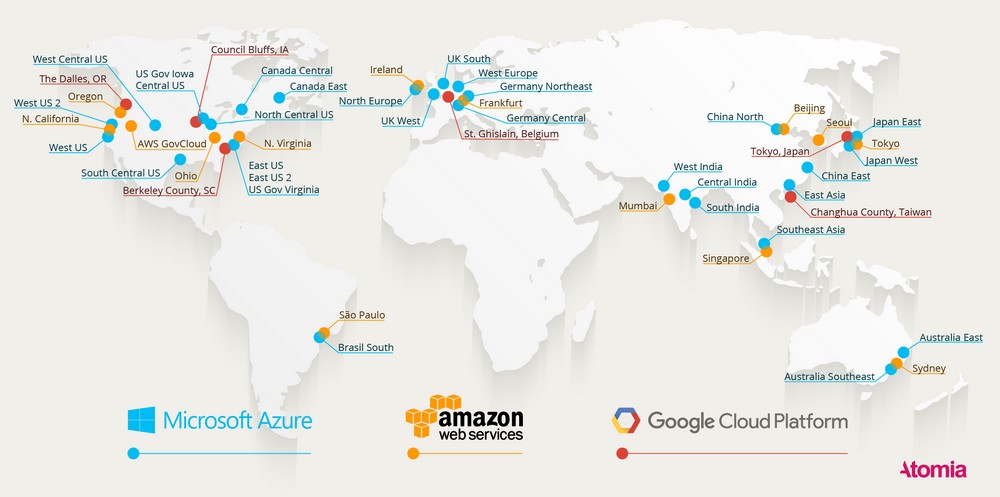
Forrás: Amazon World Services
The future will be for the locations, as the biggest ones are looking for new centers to further strengthen global product chains with regional roles as well. The three largest companies and service providers will build a total of 20 locations in the coming years: six in North America, one in South America, six in Asia, and seven in Europe: the question is where the new technology market distribution centers will go?
The author is the chairman of the board of trustees of the Pallas Athene Domus Meriti Foundation (PADME).
